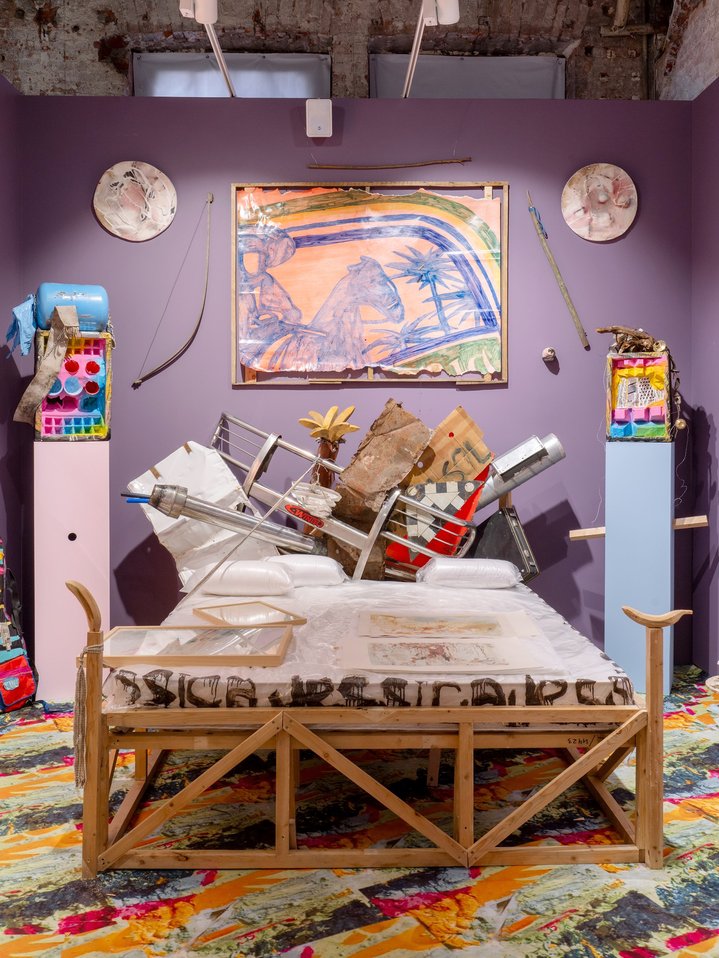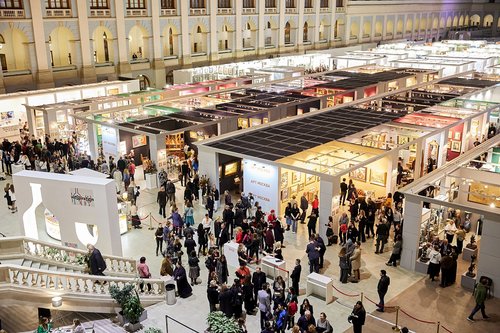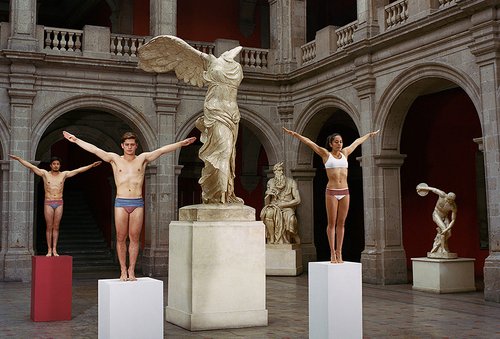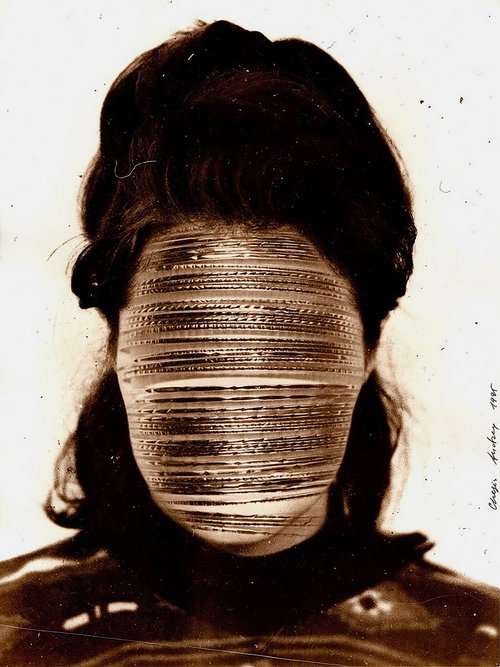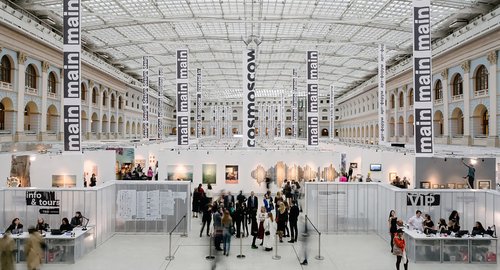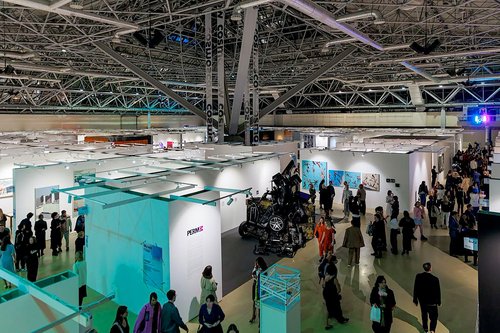The second edition of |catalog| contemporary art fair. Photo by Nikolay Kashcheev. Courtesy of of |catalog| contemporary art fair
Art Fairs Go Forth and Multiply in Russia
Two rival art fairs, |catalog| and Art Moscow, vied for collectors’ roubles this month in the Russian capital and it seems there was more than ample place for both in what is now an entirely self-contained Russian domestic art market.
A promising newcomer on the Russian art fair scene |catalog| has recently mushroomed from the thirty-one galleries who participated in its first edition in December, to over fifty, with nearly all of them reporting brisk sales. The fair occupied two storeys of Sytin Printing House a historical building dating back to 1903 which has recently been stripped back and is in a state of seemingly endless renovation. Founded by AGA, an association of Russian galleries, it was born as a result of failed negotiations between several art dealers and Vassily Bychkov, director and founder of Art Moscow, Russia’s oldest contemporary art fair, which is now part of the twice-yearly Antique Salon. Unhappy with a hike in booth prices, AGA members decided to launch their own fair, with a trial edition held at the Vinzavod art hub. The new fair is built on democratic principles, the booths are all the same size and are distributed randomly by drawing lots.
This new initiative has lured galleries from across the country, from as far away as Vladivostok, the capital of Russia’s Far East. The non-profit Max Art Foundation, which is based in Moscow and Perm, showcased a powerful complete installation by Igor Samolet (b. 1984), featuring his signature technique of scratched prints over foam plastic panels, it was not for sale.
Prices appealed to different kinds of buyers, including new collectors. Established Moscow gallery E.K.Art Bureau exhibited works by more than thirty artists at prices ranging from 25,000 roubles (250 Euros) for works on paper by the conceptual artist Vadim Kruglikov (b. 1960) to 3.8 million roubles (38,000 Euros) for a painting by the late late Dmitry Vrubel (1960–2022). Gallery 11.12, whose owner Alexander Sharov is a co-founder of |catalog|, exhibited sculptures made out of bricks by the Krasnoyarsk artist Vasily Slonov (b. 1969). These modestly sized pieces were quite literally home-made since Slonov could not work in his studio, being currently under house arrest, as he awaits trial, charged with “spreading extremist symbolics”.
St. Petersburg’s Anna Nova Gallery proved that, even in the absence of direct flights and faced with other logistical challenges, it remains possible to bring art into Russia from abroad. The gallery offered new paintings by New York-based Ilya Fedotov-Fedorov (b. 1988), which had first been shown at an exhibition in Manhattan just a year ago. The works were priced between $6,000- and $15,000. The gallery also showed intricate drawings and plastic objects by artist Aljoscha (b. 1974), born in the town of Lozova, now in Ukraine, based now in Germany.
Even the top lots at |catalog| were priced moderately. Marina Gisich from St. Petersburg offered a work by Kerim Ragimov (b. 1970) for 5,000,000 roubles (50,000 Euros). Moscow’s Vellum, with its usual focus on the 1960s, offered two paintings by Ernst Neizvestny (1925–2016) at 4,000,000 and 5,500,000 roubles (40,000 and 55,000 Euros).
For the first time in thirty years, the Overcoat Gallery, normally in the lining of a real overcoat of owner-artist Alexander Petrelli (b. 1968), had a fully-fledged booth of its own. It featured works by Arkady Nasonov (b. 1969), Dmitry Gutov (b. 1960), Sergei Shutov (b. 1955), Andrei Roiter (b. 1960) and other well-known Russian artists. This did not stop Petrelli from roaming the fair’s aisles in his ubiquitous overcoat complete with a constantly changing exhibition of small-sized works pinned to the lining: a reminder that good traditions should not be abandoned.
The next edition of |catalog| is planned for December. Time will tell if the fair proves capable of maintaining the same energetic vibe, democratic approach and high aesthetic standards while sticking to its demanding twice-a-year frequency.
Hot off the heels of |catalog| was Art Moscow and half a dozen galleries even took part in both fairs. Art Moscow takes place in the historical Gostiny Dvor building near Red Square, less than three kilometres from |catalog|, a proximity that seems to have allowed some artworks to be transported directly from one fair to the other. On Art Moscow’s opening night, E.K.Art Bureau’s booth featured the same small drawing (a children’s book illustration) by Erik Bulatov (b. 1933) at 3,200,000 roubles (32,000 Euros). Vellum offered works of the 1960s artists including its mascot Ernst Neizvestny again, adding some sculptures and drawings by Daria Konovalova-Infante (b. 1978).
The contemporary part of the fair comprising two dozen booths was hidden modestly behind a much larger antiques section with two rows of jewellery. Artist and ancient oriental art dealer Kirill Danelia offered his own works, paintings of New York’s fire hydrants at 1,000,000 roubles (10,000 Euros) apiece as well as a 6th Century stone phallus from Cambodia at 600,000 roubles (6,000 Euros). On the opening night, tireless Alexander Petrelli was roaming the aisles in his signature overcoat, offering a new series of drawings by Leonid Tishkov (b. 1953) at a modest 30,000-50,000 roubles (300–500 Euros) each.
Since most top-tier galleries boycotted Art Moscow, the organizers tried to make up for these absences by inviting renowned collectors to fill the space with works which were not for sale. Valery Dudakov showed a selection of museum-quality pieces by 1960s artists and the early 20th-century symbolist Blue Rose group. A spacious section of Stella Art Foundation invoked nostalgia for the bygone days when dealers routinely brought works by top international artists to Moscow’s art fairs and gallery shows. Featured works by Russian and international artists shown here included pieces by Vladislav Mamyshev-Monroe (1969-2013), Yuri Albert (b. 1959), Robert Mapplethorpe (1946–1989) and Erwin Wurm (b. 1954). The gem of the collection, a portrait of the institution’s founder Stella Kesaeva by Alex Katz (b. 1927) was also on show.
Livre d’artiste Club, recently founded by Boris Fridman, an avid collector of artist’s books, premiered a new publishing project at the fair. After many decades of collecting livres d’artiste, Fridman decided to produce them himself. His booth proudly showed four limited edition, unbound volumes by contemporary Russian artists. Works by Ekaterina Smirnova (b. 1970), Leonid Tishkov and Sergei Shutov, each with a print-run of just 40 copies, were offered at 500,000 roubles (5,000 Euros) each. For an eight-page, hand-tinted folder by Yuri Vaschenko (b. 1941), Fridman was asking 600,000 roubles (6,000 euros). The collector explained profits were not his goal; that he was only selling these books to fund the production of others in the future. Thanks to these projects, Art Moscow managed to save face despite the absence of the country’s most important dealers.
Looking ahead, the fair season in Russia will spread from Moscow to other cities. Coinciding with Art Moscow, Port Art Fair, a small fair focused on young artists ran in St.Petersburg’s atmospheric Sevkabel Port. It will be followed by Gazprom’s 1709 fair in June. The second edition of the Nizhny Novgorod’s works on paper fair Contour is coming up in May. A new fair called SCAN in Krasnoyarsk will run at the end of June into the first week of July, showcasing Siberian art.
This proliferation of contemporary art fairs in Russia despite the small number of galleries and the recent wholesale emigration of artists may seem a paradox. Yet, many other features of the Russian art market are no less surprising to a Western eye. In the West, auction houses and galleries work in parallel, occupying different niches, with galleries operating mainly in the primary and auctions in the secondary market. In Russia, it does not raise eyebrows when a gallerist launches his own auction house and offers at auction new works fresh from an artist’s studio. In Russia art fairsoften make up for the lack of galleries outside the capital. Many Russian art fairs survive and even thrive by lending booths to individual artists, rather than to galleries. A prime example is Art Russia, which ran at Gostiny Dvor at the end of March. Moscow’s Blazar, St. Petersburg’s Port Art Fair and Third Place Fair as well as SCAN, the Siberian newcomer, function along the same lines. Art Moscow even has a section funded by the Moscow city government where artists represent themselves.
The future will show if these strategies prove effective in the long run. Yet, with more and more artists being blacklisted and banned from state museums, the art market is turning into a space of relative freedom, where, despite self-censorship and fear of persecution, independent artistic voices still can be heard.
|catalog|
April 12–14 (preview April 10–11)
Art Moscow
April 16–21






